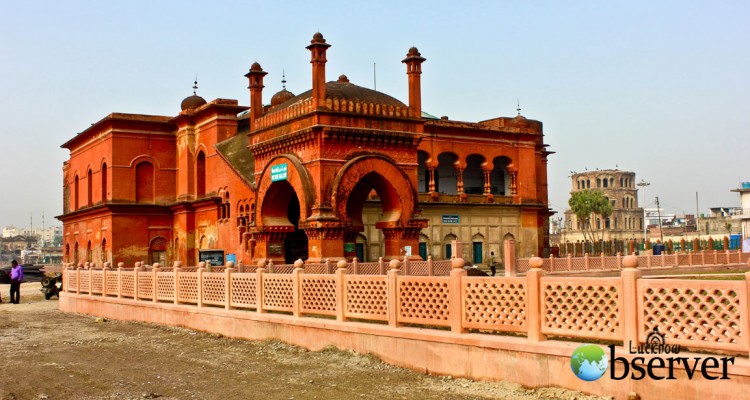The Picture Gallery’s Story and the Tales it Tells
Sumbul Zehra
Housed in bright red stone building with a large pond in front of it, the Picture Gallery of Lucknow is beautifully set against the canvas of old part of the city. The fiery red terracotta structure surrounded by lush green trees looks like a painting pulled out of the frame of a magnum opus.
When Nawab Mohammad Ali Shah (the third Nawab of Awadh) started the construction of the Picture Gallery in 1838, he had in mind a royal summer house that would serve the royal families of the time. Little did he know that it will become much more, a prized destination for those seeking to see every inch of the city, that is everything from ‘Awadh’ to ‘Lucknow’.
The gallery stands near Chota Imambara in Hussainabad, monumentally perhaps the richest area of the city, extending from the great Bara Imambara of Asaf-ud-Daulah to Jama Masjid via Chhota Imambara. In fact it has figured among three heritage zones of the city. When visiting Lucknow, it is inevitable and unaffordable to miss out on the Picture Gallery, famous for its mysterious paintings.
As was the trend in those times of constructing buildings with twelve doorways, the picture gallery project too was undertaken with similar style and was thus also referred to as Baradari in contemporary accounts (bara meaning twelve and dari has derived from the word dar meaning archway/ doorway).
In front of the gallery, a talaab (pond) was built a year after its completion around 1839. A small mosque and a matching hamam (bath) were also built at the two corners of the talab. A serai (inn) and a Mina bazaar (market) were constructed in front of the gallery alongwith a feelkhana (stables for elephants) and an astabal (stables for horses). The gallery contains iron pillars in the upper storey pavilion facing the talaab and this had been used thus for the first time in the Nawabi buildings. Mohammed Ali Shah also built a Gendghar (bowling alley) near the gallery for the entertainment of his English friends, which doesn’t exist today.
There are around thirty stairs on which the Picture gallery stands. It is open on all days from 8:00 am in the morning to 18:00 hours in the evening. An added advantage is that Hussainabad Clock Tower and Satkhanda can be seen in the vicinity of the gallery. Clock tower is a sixty seven meter high gothic tower, the highest in the country and Satkhanda is a structure that has an architectural style similar to Babylon minaret or floating garden. It is said that after the annexation of Awadh by the British, some of the buildings of Hussainabad were destroyed by the British. But in case of the Baradari complex, the british appear to have made amends by additions and alterations.
When the British handed it over to the Anjuman of Talukdars of Awadh the Baradari complex was known as the Taluqadar Hall. However, later it was used as a ‘Picture Gallery’ that came to display large, full length portraits of the Nawabs of Awadh that had been painted between 1882-1885 by visiting European artists (some of them being, Harrison, Dawling and Gravet and one Indian artist D.S.Singh). Photographs of administrators and officials of the Colonial period were added in the gallery, which hang on the walls of The Picture Gallery even today, adding another dimension to the history of Awadh.
Many tales- real or imaginary about the paintings housed by the gallery, enrich the place with a sense of hidden treasure (in the area) and a cold suspense. The paintings consist of life size portraits of Nawabs, peering down at the visitors with an air of royalty and anger in some cases. The color used in the paintings seem to emit light when one is told that the paint used was actually extracted from real diamonds. Though that hardly seems possible, anything could have been possible in the rich times Awadh has witnessed. The canvas of the painting is said to be made from elephant skin, which is evident from the sturdy sheets of age old paintings. The peculiarity about the paintings in the gallery is that the heads, shoes and most prominently the eyes of the Nawabs painted, seem to move as you move in the gallery. It might give anyone goose bumps to know that one is being followed wherever one goes unless one is outside the premises of the gallery.
Even in the pond outside, reflection of the gallery and its paintings is so clear that one can lucidly see the eyes of the portraits following. The only drawback about the place is that photography is prohibited. Still the paintings are so vivid, that they automatically get captured in the memory once their image is scanned by one’s eyes.
Though it’s fading color betrays its age, even today it seems to blush, being a significant reason for the city to be proud of. Not much attention was given on the restoration and repair of the building until The State Heritage Task-force met earlier this year and mooted the development of the Picture Gallery and the adjoining Hussainabad area.
Around May 2015 due to multiple earthquake tremors in the state, prominent cracks have developed in the building of the Picture gallery, especially in the record room of the monument that exhibits life-size portraits of Nawabs of Awadh who ruled between 1882 and 1885. The cracks were checked by a team from Indian Institute of technology, Kanpur’s (IIT-K) civil engineering department which inspected different sites in the city.
The government has finally woken up to the fact that this heritage zone, in spite of being the richest, oldest and most celebrated, has been the worst heeded one. The gallery acts as the sole museum- like structure in the city that houses such legendary paintings, turned priceless over time.
Measures will hopefully be taken to repair its structural problems and restore its fading color to what it originally was. It will take up a lot of time and effort to make it impeccably original, to make it look like what it would have in a 19th century time frame. It is the historicity that one longs to see in a monument and not something that makes it look closer to the contemporary times; the glaring Nawabs will see to that!
Writer is a student of Journalism and works as a freelance writer
(Published in The Lucknow Observer, Volume 2 Issue 18, Dated 05 September 2015)

